牛津译林版(2019)>选择性必修 第一册Unit 4 Exploring poetry Reading 课件(共39张PPT,内嵌视频)
文档属性
| 名称 | 牛津译林版(2019)>选择性必修 第一册Unit 4 Exploring poetry Reading 课件(共39张PPT,内嵌视频) | 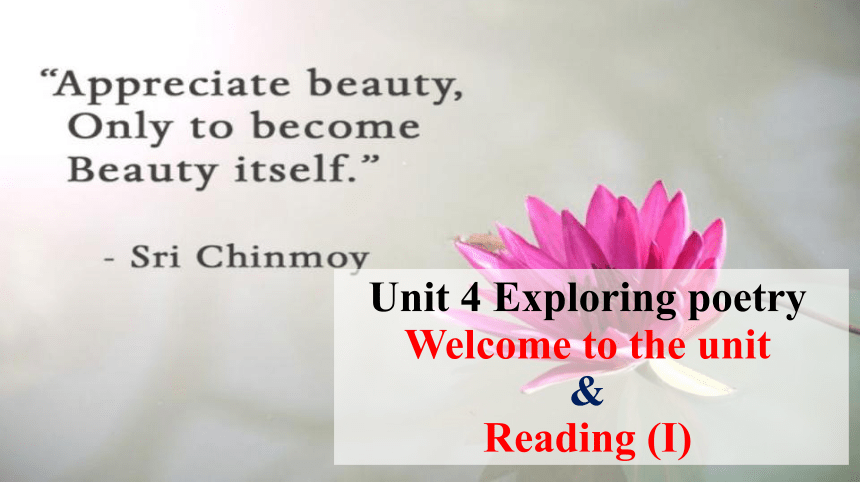 | |
| 格式 | pptx | ||
| 文件大小 | 32.9MB | ||
| 资源类型 | 教案 | ||
| 版本资源 | 牛津译林版(2019) | ||
| 科目 | 英语 | ||
| 更新时间 | 2024-07-25 09:27:57 | ||
图片预览

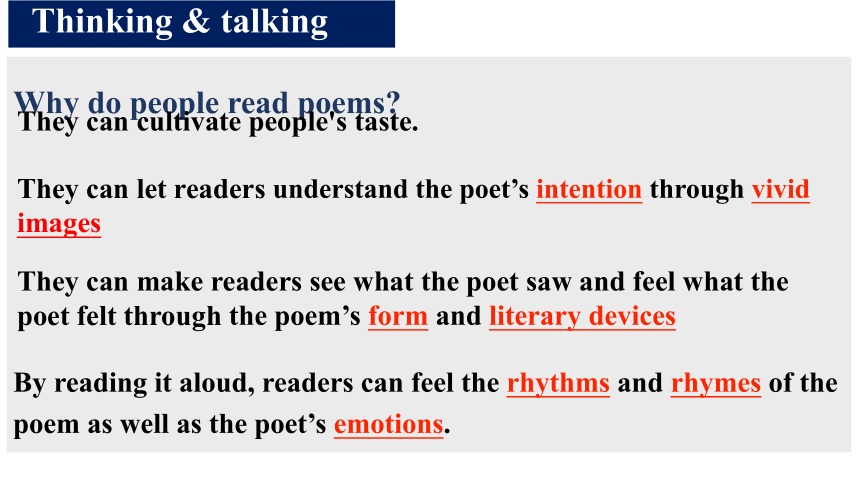
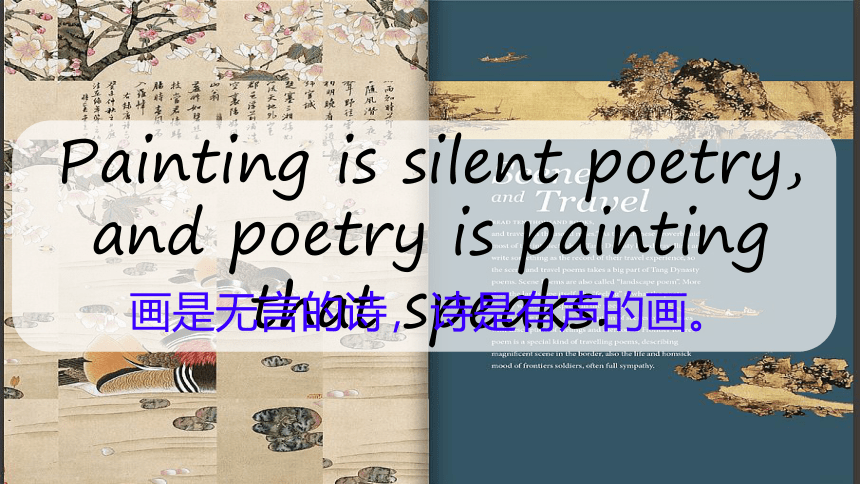
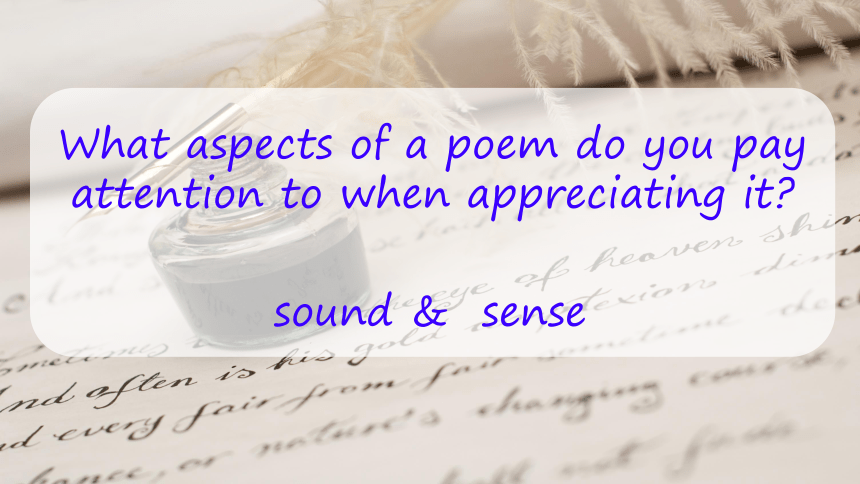

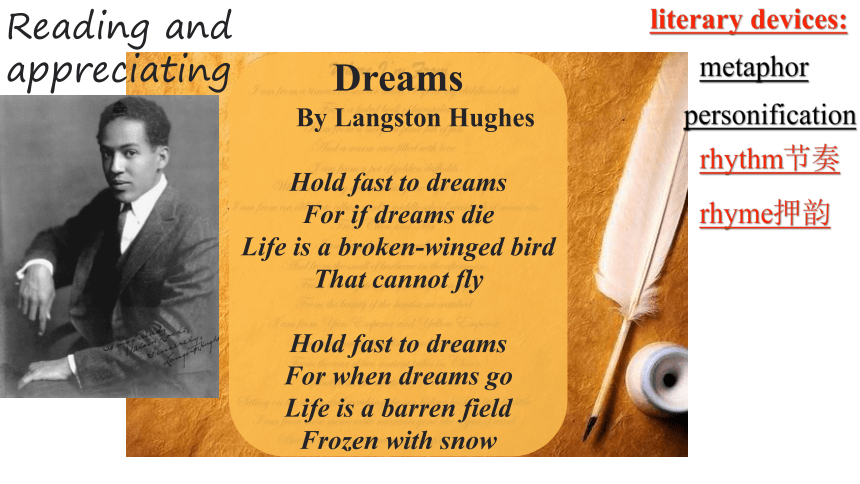
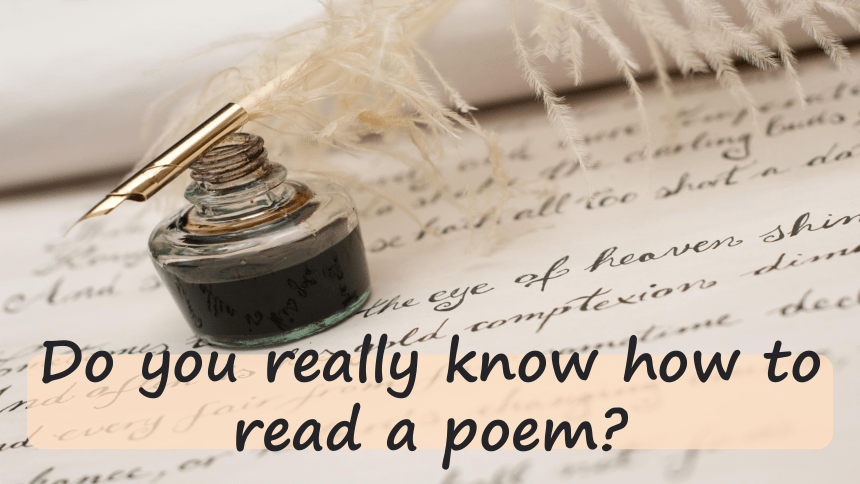
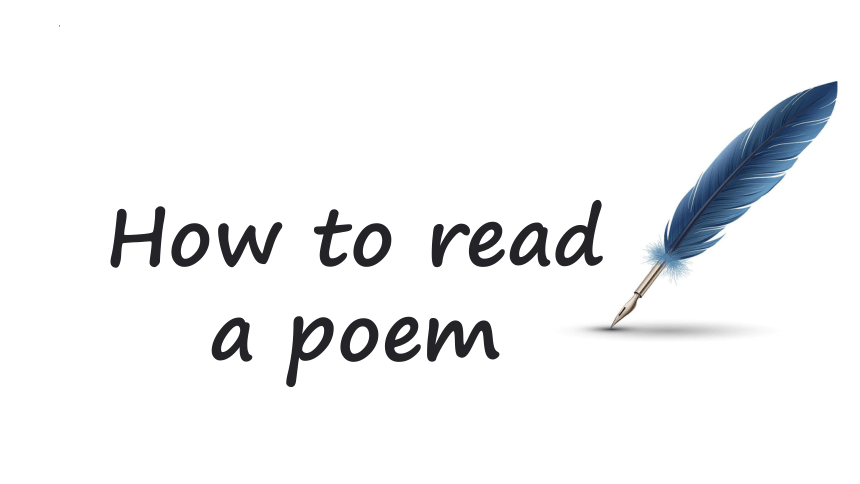
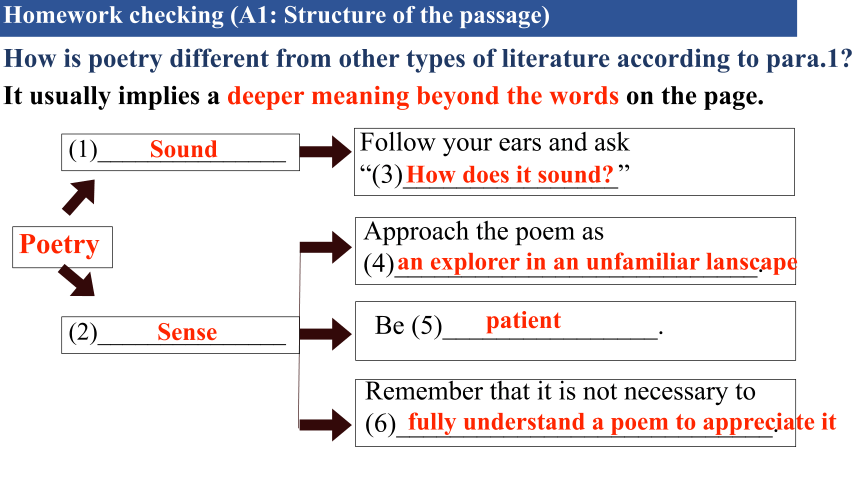
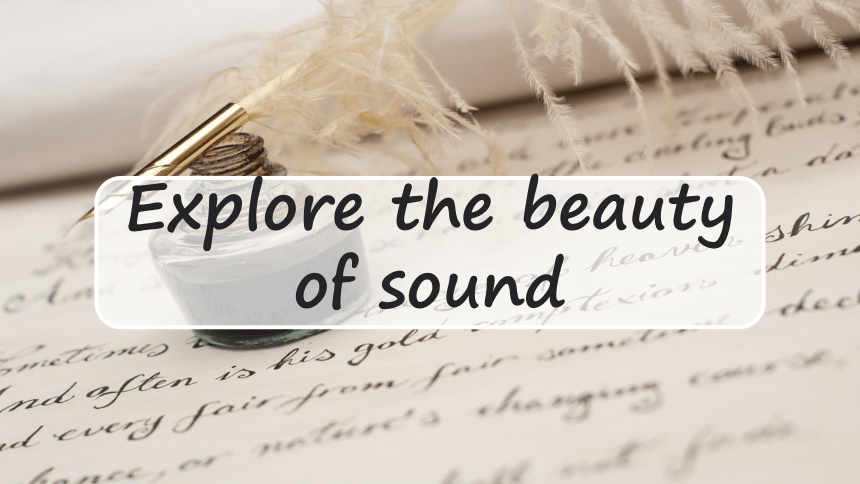
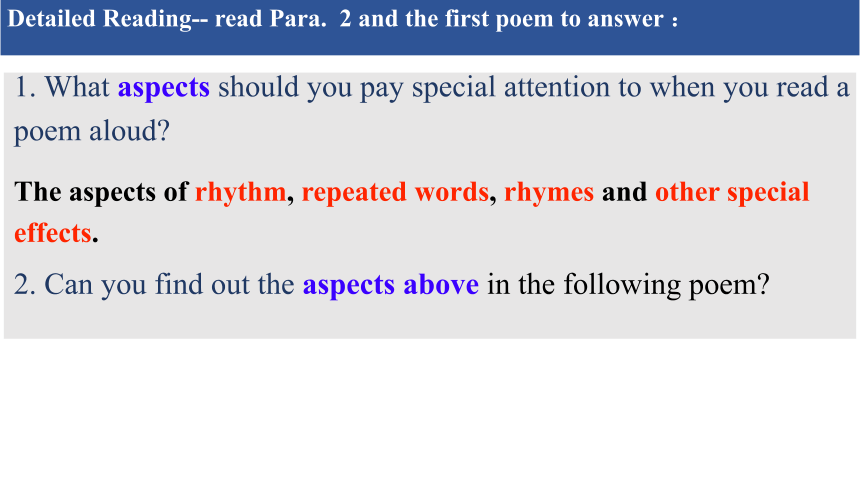
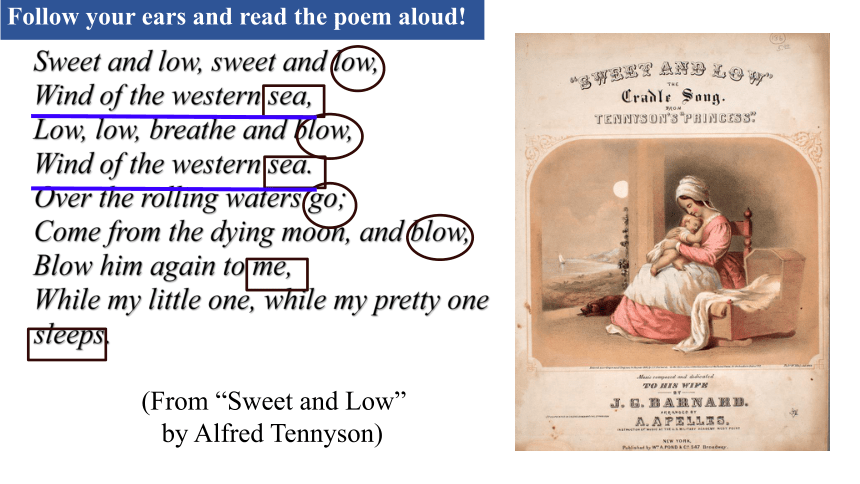
文档简介
(共39张PPT)
Unit 4 Exploring poetry
Welcome to the unit
&
Reading (I)
Thinking & talking
Why do people read poems
By reading it aloud, readers can feel the rhythms and rhymes of the poem as well as the poet’s emotions.
They can cultivate people's taste.
They can let readers understand the poet’s intention through vivid images
They can make readers see what the poet saw and feel what the poet felt through the poem’s form and literary devices
Painting is silent poetry,
and poetry is painting that speaks.
画是无言的诗,诗是有声的画。
What aspects of a poem do you pay attention to when appreciating it
sound & sense
A Spring Morning
By Meng Haoran
This spring morning in bed I’m lying,
Not to awake till birds are crying.
After one night of wind and showers,
How many are the fallen flowers!
Translated by Xu Yuanchong
Reading and appreciating
Dreams
By Langston Hughes
Hold fast to dreams
For if dreams die
Life is a broken-winged bird
That cannot fly
Hold fast to dreams
For when dreams go
Life is a barren field
Frozen with snow
Reading and appreciating
metaphor
personification
literary devices:
rhythm节奏
rhyme押韵
Do you really know how to read a poem
How to read a poem
(1)_______________
Homework checking (A1: Structure of the passage)
Poetry
(2)_______________
Follow your ears and ask
“(3)________________”
Approach the poem as
(4)___________________________.
Be (5)________________.
Remember that it is not necessary to
(6)____________________________.
Sound
Sense
How does it sound
an explorer in an unfamiliar lanscape
patient
fully understand a poem to appreciate it
How is poetry different from other types of literature according to para.1
It usually implies a deeper meaning beyond the words on the page.
Explore the beauty of sound
1. What aspects should you pay special attention to when you read a poem aloud
2. Can you find out the aspects above in the following poem
Detailed Reading-- read Para. 2 and the first poem to answer :
The aspects of rhythm, repeated words, rhymes and other special effects.
Follow your ears and read the poem aloud!
Sweet and low, sweet and low,
Wind of the western sea,
Low, low, breathe and blow,
Wind of the western sea.
Over the rolling waters go;
Come from the dying moon, and blow,
Blow him again to me,
While my little one, while my pretty one sleeps.
(From “Sweet and Low”
by Alfred Tennyson)
About the poet
Alfred, Lord Tennyson
(1809–1892)
More than any other Victorian-era writer, Tennyson has seemed the representative of his age. In his own day he was said to be—with Queen Victoria and Prime Minister William Gladstone—one of the three most famous living persons, a reputation no other poet writing in English has ever had.
Explore the beauty of sense
Detailed Reading: read Para. 3 and the second poem to finish the chart.
Approach the poem as if you were an _______ in an unfamiliar_________ As you approach the poem, you should ask:
As you explore the poem, you should ask:
As you slowly explore your surroundings, you will
explorer
landscape
Who is talking Who is being talked to What is being described Is there a sense of place Are there other people or objects there
What are the images
What happens when they are put together
start to ___________ that give you a greater _______________ of the poem.
dig up clues
understanding
explore the unfamiliar landscape
What images come into your mind when reading it
When I read it, I can see in my mind the image of a bird kept in a cage, which is desperately singing for freedom.
The caged bird sings
with a fearful trill
of things unknown
but longed for still
and his tune is heard
on the distant hill
for the caged bird
sings of freedom.
(From “Caged Bird”
by Maya Angelou)
the image in the poem
An acclaimed American poet, storyteller, activist, and autobiographer, Angelou worked for Dr. Martin Luther King Jr. and was also an educator who served as a professor in the university.
About the poet
Detailed Reading-- read Para. 4-5 and the third poem to answer
What does the lecturer think of poems that are easy to understand
What should you do when you have difficulty in understanding a poem
According to the lecturer, what is more important in appreciating a poem
What is the function of the poem quoted after Para. 4
Detailed Reading: read Pa. 4-5 and the third poem and answer
What does the lecturer think of poems that are easy to understand
They are often less interesting than those that constantly reveal deeper and previously unrecognized meanings.
2. What should you do when you have difficulty in understanding a poem
We should set it aside and come back to it later. With our insight into life becoming deeper, we may one day find it not so hard to understand at all.
Homework
I. Conclude the four tips according to the passage and finish part I in the handout.
II. 词汇手册: p63一、二
拓展阅读:KKL-p88(一)
Review the tips
Four tips on how to read a poem
First, ______________________. If the true meaning is ______________________, pay attention to the sound of it. For example, read the poem aloud to _______
__________________________________.
Second, approach the poem _______________________________________________________. Ask some basic questions about the poem. Sometimes, several images are
____________. This combination is often __________ or even _________________. As you slowly explore your surroundings, you will start to _________________ that give you a greater understanding of the poem.
Third, if you find it hard to ________________________ of a poem at the moment, just have some _____________. You can ___________ and come back to it later. Sometimes reading a poem can be _______________________.
Finally, you do not have to _____________________ a poem to appreciate it. You might need to _________________________ to discover its true _____________________. Reading poetry will surely be enjoyable and let you ___________________________
________________________.
Four tips on how to read a poem
First, follow your ears. If the true meaning is beyond your grasp, pay attention to the sound of it. For example, read the poem aloud to detect the rhythm or rhymes.
Second, approach the poem as if you were an explorer in an unfamiliar landscape. Ask some basic questions about the poem. Sometimes, several images are combined. This combination is often complex or even contradictory. As you slowly explore your surroundings, you will start to dig up clues that give you a greater understanding of the poem.
Third, if you find it hard to interpret the meaning of a poem at the moment, just have some patience. You can set it aside and come back to it later. Sometimes reading a poem can be a lifelong job.
Finally, you do not have to fully understand a poem to appreciate it. You might need to abandon logical thinking to discover its true inner beauty. Reading poetry will surely be enjoyable and let you perceive another level of meaning.
explore the meaning
This poem is not easy to understand and is suitable as an example to support the tip of “be patient when having trouble in understanding a poem”.
Whose woods these are I think I know.
His house is in the village though;
He will not see me stopping here
To watch his woods fill up with snow.
From “Stopping by Woods on a Snowy Evening” by Robert Frost
4. What is the function of the poem quoted after Para. 4
About the poet
Robert Frost (1874-1963) was an American poet who was much admired for his description of the rural life of New England, and his realistic poetry portraying ordinary people in everyday situations. His famous poems include: Stopping by Woods on a Snowy Evening and The Road Not Taken.
3. According to the lecturer, what is more important in appreciating a poem
Detailed Reading: read Para. 5 and answer
Poetry reading can make us feel something or let us perceive another level of meaning, which is more important and worth our effort.
Why doesn't the lecturer quote a poem as an example to support the fourth tip
Critical thinking
By giving the fourth tip, the lecturer emphasizes that the importance of reading poems lies in what the poem can make us feel or perceive.
As a result, it is unnecessary to give an example of a poem to support this tip since it is not related to the understanding of the content or meaning of a poem, but the readers' feelings.
Unlike the previous three tips, this tip is not focusing on the ways to understand a poem, but on what attitude and expectations readers should have when reading a poem.
Apart from the four tips given by the lecturer, what other tips can you give on how to read a poem
From my point of view, to understand a poem better, we should also know more about the poet and the background in which the poem was created—the theme of a poem usually has a close relationship with the background in which the poet wrote it.
Discussion
(1) set aside (2) remote (3) complex (4) contradictory
(5) Interpreting (6) rewarded (7) constantly (8) dig up
B1
(1) What does the author mean by “contradictory poems”
(2) Interpreting poetry can be difficult. Why does the author still enjoy it
Fill in the blanks
Answer the following questions
Can you share some experiences of your reading poems
(1) What does the author mean by “contradictory poems”
(2) Interpreting poetry can be difficult. Why does the author still enjoy it
In some poems, the poet starts with one particular image, and then adds something that seems not to be in the correct place. These lines, which stick out, make the poems interesting.
Because it makes the author wonder—sometimes it is like a riddle to solve, or a question to answer.
B1
When you are old
How do you feel when hearing the poem
How do you feel when hearing the poem
Homework
I. B1 & B2, p45
II. 词汇手册: p63三、四
III. 学案:II-A
选做拓展阅读:KKL-p89(二)
Nostalgia
Yu Guangzhong
When I was young, Nostalgia was a tiny stamp
Me on this side, Mother on the other side
When I grew up, Nostalgia was a narrow boat ticket.
Me on this side, Bride on the other side
But later on, Nostalgia was a low, low grave,
Me on the outside, Mother on the inside.
And at present, Nostalgia becomes a shallow strait
Me on this side, Mainland on the other side
sound
images
deeper meanings
Apply the tips
2.repeated sentence patterns
1.rhyme
3.short sentences with ellepsis(省略)
stamp, boat ticket, grave, shallow strait
In different periods of our life, people can be nostalgic for many things. When young, it may be ____________; when older, it may be _________________; when in the middle age, it may be __________________; As people on the island, it may be _______________________________
mother's love
the miss for the bride
the loss of his mother
the hope of unity with the mainland
Nostalgia
Yu Guangzhong
When I was young, Nostalgia was a tiny stamp
Me on this side, Mother on the other side
When I grew up, Nostalgia was a narrow boat ticket.
Me on this side, Bride on the other side
But later on, Nostalgia was a low, low grave,
Me on the outside, Mother on the inside.
And at present, Nostalgia becomes a shallow strait
Me on this side, Mainland on the other side
乡愁
余光中
小时候,
乡愁是一枚小小的邮票
我在这头,母亲在那头
长大后,
乡愁是一张窄窄的船票
我在这头,新娘在那头
后来啊,
乡愁是一方矮矮的坟墓
我在外头,母亲在里头
而现在,
乡愁是一湾浅浅的海峡
我在这头,大陆在那头
noun + verb-ing:
noun + verb-ed:
noun + adjective:
adverb + verb-ing:
painstaking, heartbreaking, time-consuming, eye-catching
snow-covered, handmade, tongue-tied, sun-dried
lifelong, world-famous, homesick, duty-free
everlasting, fast-flowing, bestselling, far-reaching
B2
full-time
lifelong
second-hand
bittersweet
like-minded
warm-hearted
wide-ranging
everlasting
outstanding
eye-catching
painstaking
cloud-capped
When I see the beautiful flowers
I can look at them for hours
My heart feels glad
And I stop feeling bad
I love their smell
And all is well
Have a try to create lines with rhymes.
Unit 4 Exploring poetry
Welcome to the unit
&
Reading (I)
Thinking & talking
Why do people read poems
By reading it aloud, readers can feel the rhythms and rhymes of the poem as well as the poet’s emotions.
They can cultivate people's taste.
They can let readers understand the poet’s intention through vivid images
They can make readers see what the poet saw and feel what the poet felt through the poem’s form and literary devices
Painting is silent poetry,
and poetry is painting that speaks.
画是无言的诗,诗是有声的画。
What aspects of a poem do you pay attention to when appreciating it
sound & sense
A Spring Morning
By Meng Haoran
This spring morning in bed I’m lying,
Not to awake till birds are crying.
After one night of wind and showers,
How many are the fallen flowers!
Translated by Xu Yuanchong
Reading and appreciating
Dreams
By Langston Hughes
Hold fast to dreams
For if dreams die
Life is a broken-winged bird
That cannot fly
Hold fast to dreams
For when dreams go
Life is a barren field
Frozen with snow
Reading and appreciating
metaphor
personification
literary devices:
rhythm节奏
rhyme押韵
Do you really know how to read a poem
How to read a poem
(1)_______________
Homework checking (A1: Structure of the passage)
Poetry
(2)_______________
Follow your ears and ask
“(3)________________”
Approach the poem as
(4)___________________________.
Be (5)________________.
Remember that it is not necessary to
(6)____________________________.
Sound
Sense
How does it sound
an explorer in an unfamiliar lanscape
patient
fully understand a poem to appreciate it
How is poetry different from other types of literature according to para.1
It usually implies a deeper meaning beyond the words on the page.
Explore the beauty of sound
1. What aspects should you pay special attention to when you read a poem aloud
2. Can you find out the aspects above in the following poem
Detailed Reading-- read Para. 2 and the first poem to answer :
The aspects of rhythm, repeated words, rhymes and other special effects.
Follow your ears and read the poem aloud!
Sweet and low, sweet and low,
Wind of the western sea,
Low, low, breathe and blow,
Wind of the western sea.
Over the rolling waters go;
Come from the dying moon, and blow,
Blow him again to me,
While my little one, while my pretty one sleeps.
(From “Sweet and Low”
by Alfred Tennyson)
About the poet
Alfred, Lord Tennyson
(1809–1892)
More than any other Victorian-era writer, Tennyson has seemed the representative of his age. In his own day he was said to be—with Queen Victoria and Prime Minister William Gladstone—one of the three most famous living persons, a reputation no other poet writing in English has ever had.
Explore the beauty of sense
Detailed Reading: read Para. 3 and the second poem to finish the chart.
Approach the poem as if you were an _______ in an unfamiliar_________ As you approach the poem, you should ask:
As you explore the poem, you should ask:
As you slowly explore your surroundings, you will
explorer
landscape
Who is talking Who is being talked to What is being described Is there a sense of place Are there other people or objects there
What are the images
What happens when they are put together
start to ___________ that give you a greater _______________ of the poem.
dig up clues
understanding
explore the unfamiliar landscape
What images come into your mind when reading it
When I read it, I can see in my mind the image of a bird kept in a cage, which is desperately singing for freedom.
The caged bird sings
with a fearful trill
of things unknown
but longed for still
and his tune is heard
on the distant hill
for the caged bird
sings of freedom.
(From “Caged Bird”
by Maya Angelou)
the image in the poem
An acclaimed American poet, storyteller, activist, and autobiographer, Angelou worked for Dr. Martin Luther King Jr. and was also an educator who served as a professor in the university.
About the poet
Detailed Reading-- read Para. 4-5 and the third poem to answer
What does the lecturer think of poems that are easy to understand
What should you do when you have difficulty in understanding a poem
According to the lecturer, what is more important in appreciating a poem
What is the function of the poem quoted after Para. 4
Detailed Reading: read Pa. 4-5 and the third poem and answer
What does the lecturer think of poems that are easy to understand
They are often less interesting than those that constantly reveal deeper and previously unrecognized meanings.
2. What should you do when you have difficulty in understanding a poem
We should set it aside and come back to it later. With our insight into life becoming deeper, we may one day find it not so hard to understand at all.
Homework
I. Conclude the four tips according to the passage and finish part I in the handout.
II. 词汇手册: p63一、二
拓展阅读:KKL-p88(一)
Review the tips
Four tips on how to read a poem
First, ______________________. If the true meaning is ______________________, pay attention to the sound of it. For example, read the poem aloud to _______
__________________________________.
Second, approach the poem _______________________________________________________. Ask some basic questions about the poem. Sometimes, several images are
____________. This combination is often __________ or even _________________. As you slowly explore your surroundings, you will start to _________________ that give you a greater understanding of the poem.
Third, if you find it hard to ________________________ of a poem at the moment, just have some _____________. You can ___________ and come back to it later. Sometimes reading a poem can be _______________________.
Finally, you do not have to _____________________ a poem to appreciate it. You might need to _________________________ to discover its true _____________________. Reading poetry will surely be enjoyable and let you ___________________________
________________________.
Four tips on how to read a poem
First, follow your ears. If the true meaning is beyond your grasp, pay attention to the sound of it. For example, read the poem aloud to detect the rhythm or rhymes.
Second, approach the poem as if you were an explorer in an unfamiliar landscape. Ask some basic questions about the poem. Sometimes, several images are combined. This combination is often complex or even contradictory. As you slowly explore your surroundings, you will start to dig up clues that give you a greater understanding of the poem.
Third, if you find it hard to interpret the meaning of a poem at the moment, just have some patience. You can set it aside and come back to it later. Sometimes reading a poem can be a lifelong job.
Finally, you do not have to fully understand a poem to appreciate it. You might need to abandon logical thinking to discover its true inner beauty. Reading poetry will surely be enjoyable and let you perceive another level of meaning.
explore the meaning
This poem is not easy to understand and is suitable as an example to support the tip of “be patient when having trouble in understanding a poem”.
Whose woods these are I think I know.
His house is in the village though;
He will not see me stopping here
To watch his woods fill up with snow.
From “Stopping by Woods on a Snowy Evening” by Robert Frost
4. What is the function of the poem quoted after Para. 4
About the poet
Robert Frost (1874-1963) was an American poet who was much admired for his description of the rural life of New England, and his realistic poetry portraying ordinary people in everyday situations. His famous poems include: Stopping by Woods on a Snowy Evening and The Road Not Taken.
3. According to the lecturer, what is more important in appreciating a poem
Detailed Reading: read Para. 5 and answer
Poetry reading can make us feel something or let us perceive another level of meaning, which is more important and worth our effort.
Why doesn't the lecturer quote a poem as an example to support the fourth tip
Critical thinking
By giving the fourth tip, the lecturer emphasizes that the importance of reading poems lies in what the poem can make us feel or perceive.
As a result, it is unnecessary to give an example of a poem to support this tip since it is not related to the understanding of the content or meaning of a poem, but the readers' feelings.
Unlike the previous three tips, this tip is not focusing on the ways to understand a poem, but on what attitude and expectations readers should have when reading a poem.
Apart from the four tips given by the lecturer, what other tips can you give on how to read a poem
From my point of view, to understand a poem better, we should also know more about the poet and the background in which the poem was created—the theme of a poem usually has a close relationship with the background in which the poet wrote it.
Discussion
(1) set aside (2) remote (3) complex (4) contradictory
(5) Interpreting (6) rewarded (7) constantly (8) dig up
B1
(1) What does the author mean by “contradictory poems”
(2) Interpreting poetry can be difficult. Why does the author still enjoy it
Fill in the blanks
Answer the following questions
Can you share some experiences of your reading poems
(1) What does the author mean by “contradictory poems”
(2) Interpreting poetry can be difficult. Why does the author still enjoy it
In some poems, the poet starts with one particular image, and then adds something that seems not to be in the correct place. These lines, which stick out, make the poems interesting.
Because it makes the author wonder—sometimes it is like a riddle to solve, or a question to answer.
B1
When you are old
How do you feel when hearing the poem
How do you feel when hearing the poem
Homework
I. B1 & B2, p45
II. 词汇手册: p63三、四
III. 学案:II-A
选做拓展阅读:KKL-p89(二)
Nostalgia
Yu Guangzhong
When I was young, Nostalgia was a tiny stamp
Me on this side, Mother on the other side
When I grew up, Nostalgia was a narrow boat ticket.
Me on this side, Bride on the other side
But later on, Nostalgia was a low, low grave,
Me on the outside, Mother on the inside.
And at present, Nostalgia becomes a shallow strait
Me on this side, Mainland on the other side
sound
images
deeper meanings
Apply the tips
2.repeated sentence patterns
1.rhyme
3.short sentences with ellepsis(省略)
stamp, boat ticket, grave, shallow strait
In different periods of our life, people can be nostalgic for many things. When young, it may be ____________; when older, it may be _________________; when in the middle age, it may be __________________; As people on the island, it may be _______________________________
mother's love
the miss for the bride
the loss of his mother
the hope of unity with the mainland
Nostalgia
Yu Guangzhong
When I was young, Nostalgia was a tiny stamp
Me on this side, Mother on the other side
When I grew up, Nostalgia was a narrow boat ticket.
Me on this side, Bride on the other side
But later on, Nostalgia was a low, low grave,
Me on the outside, Mother on the inside.
And at present, Nostalgia becomes a shallow strait
Me on this side, Mainland on the other side
乡愁
余光中
小时候,
乡愁是一枚小小的邮票
我在这头,母亲在那头
长大后,
乡愁是一张窄窄的船票
我在这头,新娘在那头
后来啊,
乡愁是一方矮矮的坟墓
我在外头,母亲在里头
而现在,
乡愁是一湾浅浅的海峡
我在这头,大陆在那头
noun + verb-ing:
noun + verb-ed:
noun + adjective:
adverb + verb-ing:
painstaking, heartbreaking, time-consuming, eye-catching
snow-covered, handmade, tongue-tied, sun-dried
lifelong, world-famous, homesick, duty-free
everlasting, fast-flowing, bestselling, far-reaching
B2
full-time
lifelong
second-hand
bittersweet
like-minded
warm-hearted
wide-ranging
everlasting
outstanding
eye-catching
painstaking
cloud-capped
When I see the beautiful flowers
I can look at them for hours
My heart feels glad
And I stop feeling bad
I love their smell
And all is well
Have a try to create lines with rhymes.
同课章节目录
- Unit 1 Food matters
- Welcome to the unit
- Reading
- Grammar and usage
- Integrated skills
- Extended reading
- Project
- Unit 2 The Universal Language
- Welcome to the unit
- Reading
- Grammar and usage
- Integrated skills
- Extended reading
- Project
- Unit 3 The art of painting
- Welcome to the unit
- Reading
- Grammar and usage
- Integrated skills
- Extended reading
- Project
- Unit 4 Exploring poetry
- Welcome to the unit
- Reading
- Grammar and usage
- Integrated skills
- Extended reading
- Project
